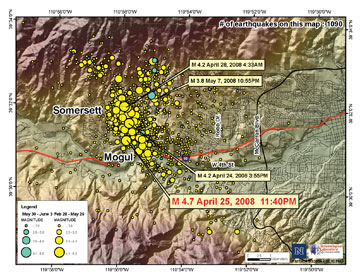|
NEWS NOTES
Hundreds of quakes rock Reno suburbs
 Nevada Seismological Laboratory |
| A swarm of 1,090 quakes rocked the suburbs of Reno, Nev., between Feb. 28 and June 3. |
John Anderson, head of the Nevada Seismological Laboratory at the University of Nevada in Reno, tracks earthquakes across the state. His office, where he spends hours poring over maps and seismological data, is in Reno. But lately, work has been following him home to the tiny bedroom community of Mogul.
On February 28, the ground beneath Mogul began shaking, and as of early June, it had not stopped. When Anderson and his colleagues mapped the epicenters of these earthquakes, they noticed a strange coincidence. The yellow dot marking the largest quake — a magnitude-5 temblor — covered Anderson’s house.
The quakes in Mogul constitute a “swarm” — a cluster of earthquakes with no obvious mainshock. Between February 28 and April 14, the laboratory recorded a magnitude-2 quake every three days or so. But on April 15, activity suddenly spiked, Anderson says. That activity culminated in three quakes larger than magnitude 4 on April 24 and 25. Since then, the quakes have been gradually tapering off. Although most of the more than a thousand tremors recorded during March, April and May were small, the larger ones cracked walls and cleared shelves.
Earthquakes aren’t uncommon in Nevada. The state is laced with hundreds of faults. And the Reno area sits atop the northern part of the Walker Lane, where there are higher activity rates, Anderson says. “This part of western Nevada has a hazard that is comparable to or higher than many parts of California.” Reno has experienced a few major earthquakes and some smaller swarms in the past. But, Anderson says, “swarms this size are less common than mainshock-aftershock sequences.”
Because the Mogul quakes have been happening over such an extended period, Anderson and his colleagues have had time to install 10 additional seismometers throughout the area. They even put one in Anderson’s garage the day after the quakes began. The extra instruments helped the team gather more data. In fact, Anderson says, the Mogul sequence is among the best studied swarms ever.
The underlying cause of all the commotion appears to be the Pacific Plate, which is pulling the Sierra Nevada mountains northwest at a rate of about 12.5 centimeters each year. But it has been difficult to pinpoint any one fault. “A lot of Nevada earthquakes have occurred on minor fault structures that have not been mapped,” Anderson says. Most of the Mogul quake epicenters are consistent with right-lateral strike-slip faulting on a northwest-trending fault that “was previously unappreciated,” he says.
So far, the team can’t say why the Mogul earthquakes are manifesting themselves as a swarm rather than a mainshock-aftershock sequence. “Some people think that maybe swarms occur in regions where the faults are less developed,” Anderson says. “I don’t have a definitive answer.”
Scientists were concerned that the larger earthquakes in the swarm might be foreshocks — harbingers of an even larger quake. But Anderson says that’s less likely now given that activity seems to be slowing.
Although the quakes have left some residents shaken, Anderson sees a silver lining: The swarm has gotten local officials and residents interested in earthquake preparedness. “Reno has a 60 or 70 percent chance of a magnitude-6 earthquake in the next 50 years,” he says. “One needs to be ready.”

 Subscribe
Subscribe


